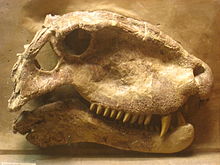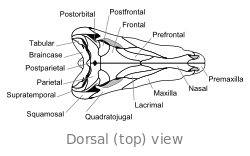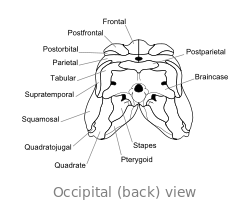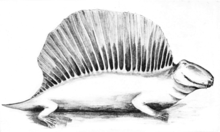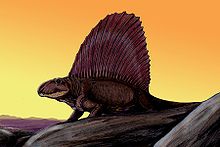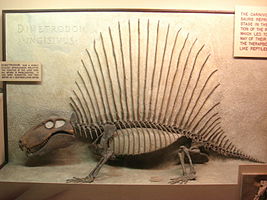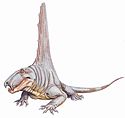
Dimetrodon
Background Information
This Wikipedia selection is available offline from SOS Children for distribution in the developing world. Sponsoring children helps children in the developing world to learn too.
| Dimetrodon Temporal range: Early Permian, 299–270Ma |
|
|---|---|
 |
|
| Mounted skeleton of Dimetrodon grandis | |
| Scientific classification |
|
| Kingdom: | Animalia |
| Phylum: | Chordata |
| Family: | †Sphenacodontidae |
| Subfamily: | †Sphenacodontinae |
| Genus: | †Dimetrodon Cope, 1878 |
| Type species | |
| †Dimetrodon limbatus (Cope, 1877 [originally Clepsydrops limbatus]) |
|
| Species | |
|
See below |
|
| Synonyms | |
|
Bathyglyptus Case, 1911 |
|
Dimetrodon ( / d aɪ ˈ m ɛ t r ə d ɒ n /; meaning "two measures of teeth") is an extinct genus of synapsid that lived during the Early Permian, around 299–270 million years ago (Ma). It is a member of the family Sphenacodontidae. The most prominent feature of Dimetrodon is the large sail on its back formed by elongated spines extending from the vertebrae. It walked on four legs and had a tall, curved skull with large teeth of different sizes set along the jaws. Most fossils have been found in the southwestern United States, the majority coming from a geological deposit called the Red Beds in Texas and Oklahoma. More recently, fossils have been found in Germany. Over a dozen species have been named since the genus was first described in 1878.
Dimetrodon is often mistaken as a dinosaur or as a contemporary of dinosaurs in popular culture, but it went extinct around 40 million years before the appearance of the first dinosaur in the Triassic period. Generally reptile-like in appearance and physiology, Dimetrodon is nevertheless more closely related to mammals than it is to any living reptilian group, though it is not a direct ancestor of any mammals. Dimetrodon belongs to a group traditionally called " mammal-like reptiles", more recently termed "stem-mammals" or "non-mammalian synapsids" because many vertebrate paleontologists today group Dimetrodon together with mammals in an evolutionary group or clade called Synapsida while dinosaurs go together with living reptiles and birds in a separate group, Sauropsida. A single large opening on either side of the back of the skull links Dimetrodon with mammals and distinguishes it from most of the earliest sauropsids, which either lack openings or have two openings. Features such as ridges on the inside of the nasal cavity and a ridge at the back of the lower jaw are thought to be part of an evolutionary progression from early tetrapods (four-limbed vertebrates) to mammals.
Dimetrodon was probably one of the top predators in Early Permian ecosystems, feeding on fish and tetrapods, including reptiles as well as amphibians. Smaller Dimetrodon species may have had different ecological roles. The sail of Dimetrodon may have been used to stabilize its spine or to heat and cool its body as a form of thermoregulation. Some recent studies argue that the sail would have been ineffective at removing heat from the body, and was more likely used in sexual display.
Description and paleobiology
Dimetrodon was a quadrupedal, sail-backed synapsid. Most Dimetrodon species ranged in length from 1.7 to 3.2 metres (5.6 to 10 ft) and are estimated to have weighed between 28 and 250 kilograms (62 and 550 lb). The largest known species of Dimetrodon is D. grandis at 3.2 metres (10 ft) and the smallest is D. teutonis at 60 centimetres (24 in). The larger species of Dimetrodon were among the largest predators of the Early Permian, although the closely related Tappenosaurus, known from skeletal fragments in slightly younger rocks, may have been even larger at an estimated 18 feet (5.5 m) in total body length.
Skull
The skull of Dimetrodon is tall and compressed laterally, or side-to-side. The eye sockets are positioned high and far back in the skull. Behind each eye socket is a single hole called an infratemporal fenestra. Two additional pairs of holes can be seen at the back of the skull when viewed from above: the supratemporal fenestra and the posttemporal fenestra. The back of the skull (the occiput) is oriented at a slight upward angle, a feature that it shares with all other early synapsids. The upper margin of the skull slopes downward in a convex arc to the tip of the snout. The tip of the upper jaw, formed by the premaxilla bone, is raised above the part of the jaw formed by the maxilla bone to form a maxillary "step." Within this step is a diastema, or gap in the tooth row.
Teeth
The size of teeth differs greatly along the length of the jaws, lending Dimetrodon its name, which means "two shapes of tooth" in reference to sets of small and large teeth. One or two pairs of caniniforms (large pointed canine-like teeth) extend from the maxilla. Large incisor teeth are also present at the tips of the upper and lower jaws, rooted in the premaxillae and dentary bones. Small teeth are present around the maxillary "step" and behind the caniniforms, becoming smaller further back in the jaw.
Many teeth are widest at their midsections and narrow closer to the jaws, giving them the appearance of a teardrop. Teardrop-shaped teeth are unique to Dimetrodon and other closely related sphenacodontids, and help distinguish them from other early synapsids. As in many other early synapsids, the teeth of most Dimetrodon species are serrated at their edges. The teeth of D. teutonis lack serrations, but still have sharp edges.
Nasal cavity
On the inner surface of the nasal section of skull are ridges called nasoturbinals, which may have supported cartilage that increased the area of the olfactory epithelium, the layer of tissue that detects odours. These ridges are much smaller than those of later synapsids from the Late Permian and Triassic, whose large nasoturbinals are taken as evidence for warm-bloodedness because they may have supported mucous membranes that warmed and moistened incoming air. Thus, the nasal cavity of Dimetrodon is transitional between those of early land vertebrates and mammals.
Jaw joint and ear
Another transitional feature of Dimetrodon is a ridge in the back of the jaw called the reflected lamina. The reflected lamina is found on the articular bone, which connects to the quadrate bone of the skull to form the jaw joint. In later mammal ancestors, the articular and quadrate separated from the jaw joint while the articular developed into the malleus bone of the inner ear. The reflected lamina became part of a ring called the tympanic annulus that supports the ear drum in all living mammals.
Tail
The tail of Dimetrodon makes up a large portion of its total body length and includes around 50 caudal vertebrae. Tails were missing or incomplete in the first described skeletons of Dimetrodon; the only caudal vertebrae known were the eleven closest to the hip. Since these first few caudal vertebrae narrow rapidly as they progress farther from the hip, many paleontologists in the late nineteenth and early twentieth centuries thought that Dimetrodon had a very short tail. It was not until 1927 that a largely complete tail of Dimetrodon was described.
Sail
The sail of Dimetrodon is formed by elongated neural spines projecting from the vertebrae. Each spine varies in cross-sectional shape from its base to its tip in what is known as "dimetrodont" differentiation. Near the vertebra body, the spine cross section is laterally compressed into a rectangular shape, and closer to the tip, it takes on a figure-eight shape as a groove runs along either side of the spine. The figure-eight shape is thought to reinforce the spine, preventing bending and fractures. A cross section of the spine of one specimen of Dimetrodon giganhomogenes is rectangular in shape but preserves figure-eight shaped rings close to its centre, indicating that the shape of spines may change as individuals age. The microscopic anatomy of each spine varies from base to tip, indicating where it was embedded in the muscles of the back and where it was exposed as part of a sail. The lower or proximal portion of the spine has a rough surface that would have served as an anchoring point for the epaxial muscles of the back, and also has a network of connective tissues called Sharpey's fibers that indicate it was embedded within the body. Higher up on the distal (outer) portion of the spine, the bone surface is smoother. The periosteum, a layer of tissue surrounding the bone, is covered in small grooves that presumably supported the blood vessels that vascularized the sail. The large groove that runs the length of the spine was once thought to be a channel for blood vessels, but since the bone does not contain vascular canals, the sail is not thought to have been as highly vascularized as once thought. Some specimens of Dimetrodon preserve deformed areas of the neural spines that appear to be healed-over fractures. The cortical bone that grew over these breaks is highly vascularized, suggesting that soft tissue must have been present on the sail to supply the site with blood vessels. Layered lamellar bone makes up most of the neural spine's cross-sectional area, and contains lines of arrested growth that can be used to determine the age of each individual at death. In many specimens the distal portions of spines bend sharply, indicating that the sail would have had an irregular profile in life. Their crookedness suggests that soft tissue may not have extended all the way to the tips of the spines, meaning that the sail's webbing may not have been as extensive as it is commonly imagined.
Thermoregulatory function
Paleontologists have proposed many ways in which the sail could have functioned in life. Some of the first to think about its purpose suggested that the sail may have served as camouflage among reeds while Dimetrodon waited for prey, or as an actual boat-like sail to catch the wind while the animal was in the water. Another is that the long neural spines could have stabilized the trunk by restricting up-and-down movement, which would allow for a more efficient side-to-side movement while walking. In 1940, Alfred Romer and Llewellyn Ivor Price proposed that the sail served a thermoregulatory function, allowing individuals to warm their bodies with the sun's heat. In the following years, many models were created to estimate the effectiveness of thermoregulation in Dimetrodon. For example, in a 1973 article in the journal Nature, paleontologists C. D. Bramwell and P. B. Fellgett estimated that it took a 200 kilograms (440 lb) individual about one and a half hours for its body temperature to rise from 26 to 32 °C (79 to 90 °F). In 1986, Steven C. Haack concluded that the warming was slower than previously thought and that the process probably took four hours. Using a model based on a variety of environmental factors and hypothesized physiological aspects of Dimetrodon, Haack found that the sail allowed Dimetrodon to warm faster in the morning and reach a slightly higher body temperature during the day, but that it was ineffective in releasing excess heat and did not allow Dimetrodon to retain a higher body temperature at night. In 1999, a group of mechanical engineers created a computer model to analyze the ability of the sail to regulate body temperature during different seasons, and concluded that the sail was beneficial for capturing and releasing heat at all times in the year.
Most of these studies give two thermoregulatory roles for the sail of Dimetrodon: one as a means of warming quickly in the morning, and another as a way to cool down when body temperature becomes high. Dimetrodon and all other Early Permian land vertebrates are assumed to have been cold-blooded or poikilothermic, relying on the sun to maintain a high body temperature. Because of its large size, Dimetrodon had high thermal inertia, meaning that changes in body temperature occurred more slowly in it than in smaller-bodied animals. As temperatures rose in the mornings, the small-bodied prey of Dimetrodon could warm their bodies much faster than could something the size of Dimetrodon. Many paleontologists including Haack have proposed that the sail of Dimetrodon may have allowed it to warm quickly in the morning in order to keep pace with its prey. The sail's large surface area also meant heat could dissipate quickly into the surroundings, useful if the animal needed to release excess heat that was produced from metabolism or that was absorbed by the sun. Dimetrodon may have angled its sail away from the sun to cool off or restricted blood flow to the sail to maintain heat at night.
In 1986, J. Scott Turner and C. Richard Tracy proposed that the evolution of a sail in Dimetrodon was related to the evolution of warm-bloodedness in mammal ancestors. They thought that the sail of Dimetrodon enabled it to be homeothermic, maintaining a constant, albeit low, body temperature. Mammals are also homeothermic, although they differ from Dimetrodon in being endothermic, controlling their body temperature internally through heightened metabolism. Turner and Tracy noted that the long limbs of early therapsids, a more advanced group of synapsids that are closely related to mammals, allowed them to release heat in a similar way to the sail of Dimetrodon. The homeothermy that developed in animals like Dimetrodon may have carried over to therapsids through a modification of body shape, which would eventually develop into the warm-bloodedness of mammals.
Recent studies on the sail of Dimetrodon and other sphenacodontids support Haack's 1986 contention that the sail was poorly adapted to releasing heat and maintaining a stable body temperature. The presence of sails in small-bodied species of Dimetrodon such as D. milleri and D. teutonis does not fit the idea that the sail's purpose was thermoregulation because smaller sails are less able to transfer heat and because small bodies can absorb and release heat easily on their own. Moreover, close relatives of Dimetrodon such as Sphenacodon have very low crests that would have been useless as thermoregulatory devices. The large sail of Dimetrodon is thought to have developed gradually from these smaller crests, meaning that over most of the sail's evolutionary history, thermoregulation could not have served an important function.
Sexual selection
Larger bodied specimens of Dimetrodon have larger sails relative to their size, an example of positive allometry. Positive allometry may benefit thermoregulation because it means that, as individuals get larger, surface area increases faster than mass. Larger-bodied animals generate a great deal of heat through metabolism, and the amount of heat that must be dissipated from the body surface is significantly greater than what must be dissipated by smaller-bodied animals. Effective heat dissipation can be predicted across many different animals with a single relationship between mass and surface area. However, a 2010 study of allometry in Dimetrodon found a different relationship between its sail and body mass: the actual scaling exponent of the sail was much larger than the exponent expected in an animal adapted to heat dissipation. The researchers concluded that the sail of Dimetrodon grew at a much faster rate than was necessary for thermoregulation, and suggested that sexual selection was the primary reason for its evolution.
Sexual dimorphism
Dimetrodon may have been sexually dimorphic, meaning that males and females had slightly different body sizes. Some specimens of Dimetrodon have been hypothesized as males because they have thicker bones, larger sails, longer skulls, and more pronounced maxillary "steps" than others. Based on these differences, the mounted skeletons in the American Museum of Natural History (AMNH 4636) and the Field Museum of Natural History may be males and the skeletons in the Denver Museum of Nature and Science ( MCZ 1347) and the University of Michigan Museum of Natural History may be females.
Species
Classification history
First descriptions by Cope
Fossils now attributed to Dimetrodon were first studied by American paleontologist Edward Drinker Cope in the 1870s. Cope had obtained the fossils along with those of many other Permian tetrapods (four-limbed vertebrates) from several collectors who had been exploring a group of rocks in Texas called the Red Beds. Among these collectors were Swiss naturalist Jacob Boll, Texas geologist W. F. Cummins, and amateur paleontologist Charles Hazelius Sternberg. Most of Cope's specimens went to the American Museum of Natural History or to the University of Chicago's Walker Museum (most of the Walker fossil collection is now housed in the Field Museum of Natural History).
Sternberg sent some of his own specimens to German paleontologist Ferdinand Broili at Munich University, although Broili was not as prolific as Cope when it came to describing specimens. Cope's rival Othniel Charles Marsh also collected some bones of Dimetrodon, which he sent to the Walker Museum. The first use of the name Dimetrodon came in 1878 when Cope named the species Dimetrodon incisivus, Dimetrodon rectiformis, and Dimetrodon gigas in the scientific journal Proceedings of the American Philosophical Society.
However, the first description of a Dimetrodon fossil came a year earlier, when Cope named the species Clepsydrops limbatus from the Red Beds of Texas. (The name Clepsydrops was first coined by Cope in 1875 for sphenacodontid remains from Vermilion County, Illinois, and was later employed for many sphenacontid specimens from Texas; many new species of sphenacodontids from Texas were assigned to either Clepsydrops or Dimetrodon in the late nineteenth and early twentieth centuries.) C. limbatus was reclassified as a species of Dimetrodon in 1940, meaning that Cope's 1877 paper was the first record of Dimetrodon.
Cope was the first to describe a sail-backed synapsid with the naming of Clepsydrops natalis in his 1878 paper, although he called the sail a fin and compared it to the crests of the modern basilisk lizard (Basilicus). Sails were not preserved in the specimens of D. incisivus and D. gigas that Cope described in his 1878 paper, but elongated spines were present in the D. rectiformis specimen he described. Cope commented on the purpose of the sail in 1886, writing, "The utility is difficult to imagine. Unless the animal had aquatic habits, and swam on its back, the crest or fin must have been in the way of active movements... The limbs are not long enough nor the claws acute enough to demonstrate arboreal habits, as in the existing genus Basilicus, where a similar crest exists."
Early 20th century descriptions
In the first few decades of the twentieth century, American paleontologist E. C. Case authored many studies on Dimetrodon and described several new species. He received funding from the Carnegie Institution for his study of many Dimetrodon specimens in the collections of the American Museum of Natural History and several other museums. Many of these fossils had been collected by Cope but had not been thoroughly described, as Cope was known for erecting new species on the basis of only a few bone fragments.
Beginning in the late 1920s, paleontologist Alfred Romer restudied many Dimetrodon specimens and named several new species. In 1940, Romer coauthored a large study with Llewellyn Ivor Price called "Review of the Pelycosauria" in which the species of Dimetrodon named by Cope and Case were reassessed. Most of the species names considered valid by Romer and Price are still used today.
New specimens
In the decades following Romer and Price's monograph, many Dimetrodon specimens were described from localities outside Texas and Oklahoma. The first was described from the Four Corners region of Utah in 1966 and another was described from Arizona in 1969. In 1975, Olson reported Dimetrodon material from Ohio. A new species of Dimetrodon called D. occidentalis (meaning "western Dimetrodon") was named in 1977 from New Mexico. The specimens found in Utah and Arizona probably also belong to D. occidentalis.
Before these discoveries, a theory existed that a Midcontinental seaway separated what is now Texas and Oklahoma from more western lands during the Early Permian, isolating Dimetrodon to a small region of North America while a smaller sphenacodontid called Sphenacodon dominated the western area. While this seaway probably did exist, the discovery of fossils outside Texas and Oklahoma show that its extent was limited and that it was not an effective barrier to the distribution of Dimetrodon.
In 2001, a new species of Dimetrodon called D. teutonis was described from the Saar-Nahe Basin of Germany, extending the geographic range of Dimetrodon outside North America for the first time.
Phylogenetic classification
Dimetrodon is an early member of a group called synapsids, which include mammals and many of their extinct relatives. It is often mistaken as a dinosaur in popular culture, despite having become extinct around 40 million years (Ma) before the first dinosaurs appeared. As a synapsid, Dimetrodon is more closely related to mammals than it is to dinosaurs or any living reptile. In the late nineteenth and early twentieth centuries, most paleontologists called Dimetrodon a reptile in accordance with Linnean taxonomy. In the Linnean system, Reptilia was ranked as a class and Dimetrodon was ranked as a genus within that class. Although a close relationship between Dimetrodon and mammals was appreciated at the time, mammals belonged to their own separate class and thus Dimetrodon was a "mammal-like reptile". Paleontologists recognized that mammals evolved from this group in what they called a reptile-to-mammal transition. More recently, phylogenetic taxonomy has become a common system of classification in vertebrate paleontology whereby groups are defined by shared common ancestors. Reptiles and mammals have been placed into clades, which are groups that include a common evolutionary ancestor and all of its descendants. Under phylogenetic systematics, the descendants of the last common ancestor of Dimetrodon and all living reptiles must include all mammals because Dimetrodon is now known to be more closely related to mammals than it is to any living reptile. To avoid mammals being in the clade that includes these living reptiles, neither Dimetrodon nor any other "mammal-like reptile" can be considered part of that clade. Descendants of the last common ancestor of mammals and reptiles (which appeared around 310 Ma in the Late Carboniferous) are therefore split into two clades: Synapsida, which includes Dimetrodon and mammals, and Sauropsida, which includes living reptiles and all extinct reptiles more closely related to them than to mammals.
Within Synapsida, Dimetrodon is part of the clade Sphenacodontia. Sphenacodontia was first proposed as an early synapsid group in 1940 by paleontologists Alfred Romer and Llewellyn Ivor Price, along with the groups Ophiacodontia and Edaphosauria. All three groups are known from the Late Carboniferous and Early Permian. Romer and Price distinguished them primarily by postcranial features such as the shapes of limbs and vertebrae. Ophiacodontia was considered the most primitive group because its members appeared the most reptilian, and Sphenacodontia was the most advanced because its members appeared the most like a group called Therapsida, which included the closest relatives to mammals. Romer and Price placed another group of early syapsids called varanopids within Sphenacodontia, considering them to be more primitive than other sphenacodonts like Dimetrodon. They thought varanopids and Dimetrodon-like sphenacodonts were closely related because both groups were carnivorous, although varanopids are much smaller and more lizard-like, lacking sails. The modern view of synapsid relationships was proposed by paleontologist Robert R. Reisz in 1986, whose study included features mostly found in the skull rather than in the postcranial skeleton. Dimetrodon is still considered a sphenacodont under this phylogeny, but varanodontids are now considered more basal synapsids, falling outside Sphenacodontia. Within Sphenacodontia is the group Sphenacodontoidea, which in turn contains Sphenacodontidae and Therapsida. Sphenacodontidae is the group containing Dimetrodon and several other sail-backed synapsids like Sphenacodon and Secodontosaurus, while Therapsida includes mammals and their mostly Permian and Triassic relatives. Below is a cladogram modified from the analysis of Benson (in press) that follows this phylogeny:
| Amniota |
|
||||||||||||||||||||||||||||||||||||||||||||||||||||||||||||||||||||||||||||||
|
|
Paleoecology
Fossils of Dimetrodon are known from the United States (Texas, Oklahoma, New Mexico, Arizona, Utah and Ohio) and Germany, areas that were part of the supercontinent Euramerica during the Early Permian. Within the United States, almost all material attributed to Dimetrodon has come from three geological groups in north-central Texas and south-central Oklahoma: the Clear Fork Group, the Wichita Group, and the Pearce River Group. Most fossil finds are part of lowland ecosystems which, during the Permian, would have been vast wetlands. In particular, the Red Beds of Texas is an area of great diversity of fossil tetrapods, or four-limbed vertebrates. In addition to Dimetrodon, the most common tetrapods in the Red Beds and throughout Early Permian deposits in the southwestern United States are the amphibians Archeria, Diplocaulus, Eryops, and Trimerorhachis, the reptiliomorph Seymouria, the reptile Captorhinus, and the synapsids Ophiacodon and Edaphosaurus. These tetrapods made up a group of animals that paleontologist Everett C. Olson called the "Permo-Carboniferous chronofauna," a fauna that dominated the continental Euramerican ecosystem for several million years. Based on the geology of deposits like the Red Beds, the fauna is thought to have inhabited a well-vegetated lowland deltaic ecosystem.
Food web
Olson made many inferences on the paleoecology of the Texas Red beds and the role of Dimetrodon within its ecosystem. He proposed several main types of ecosystems in which the earliest tetrapods lived. Dimetrodon belonged to the most primitive ecosystem, which developed from aquatic food webs. In it, aquatic plants were the primary producers and were largely fed upon by fish and aquatic invertebrates. Most land vertebrates fed on these aquatic primary consumers. Dimetrodon was probably the top predator of the Red Beds ecosystem, feeding on a variety of organisms such as the large fish Xenacanthus, the aquatic amphibians Trimerorhachis and Diplocaulus, and the terrestrial tetrapods Seymouria and Trematops. Insects are known from the Early Permian Red Beds and were probably involved to some degree in the same food web as Dimetrodon, feeding small reptiles like Captorhinus. The Red Beds assemblage also included some of the first large land-living herbivores like Edaphosaurus and Diadectes. Feeding primarily on terrestrial plants, these herbivores did not derive their energy from aquatic food webs. According to Olson, the best modern analogue for the ecosystem Dimetrodon inhabited is the Everglades.
The only species of Dimetrodon found outside the southwestern United States is Dimetrodon teutonis from Germany. Its remains were found in the Tambach Formation in a fossil site called the Bromacker locality. The Bromacker's assemblage of Early Permian tetrapods is unusual in that there are few large-bodied synapsids serving the role of top predators. D. teutonis is estimated to have been only 1.7 metres (5.6 ft) in length, too small to prey on the large diadectid herbivores that are abundant in the Bromacker assemblage. It more likely ate small vertebrates and insects. Only three fossils can be attributed to large predators, and they are thought to have been either large varanopids or small sphenacodonts, both of which could potentially prey on D. teutonis. In contrast to the lowland deltaic Red Beds of Texas, the Bromacker deposits are thought to have represented an upland environment with no aquatic species. It is possible that large-bodied carnivores were not part of the Bromacker assemblage because they were dependent on large aquatic amphibians for food.
Juveniles
Although some Dimetrodon species could grow very large, many juvenile specimens are known. Paleontologist Robert T. Bakker suggested in 1982 that adult Dimetrodon inhabited open floodplains while juveniles preferred more secluded swamplands and lake margins. These environments were inferred from the type of sediment in which Dimetrodon bones were found. Bakker thought that Dimetrodon juveniles would have behaved similarly to the juveniles of living large reptiles in avoiding adults of their own species. In living reptiles, adults may compete for the same resources as their young and may even prey on them. However, a later study by Donald Brinkman cast doubt on Bakker's idea by showing that the specimens found in floodplain and swamp sediments represented two different species, not adult and juvenile populations of the same species.
